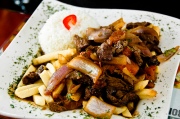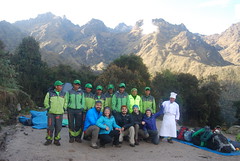Over a year ago we started working with Wakatinku village and always focused on helping their school and schoolchildren. We have installed computers and internet in the school and sponsored a teacher to make sure their English and math education continued – and it has been such a pleasure to watch these kids grow and learn during this time. We feel honored to have been a small part of it.
When the Director of the school explained to us that this would be the first graduating class ever from the school, we knew we needed to do something a little extra special for them. We invited the 17 graduating students, their families and some teachers – 52 people all together, to enjoy our 2D/1N Sacred Valley and Machu Picchu tour.
It was their first time visiting Machu Picchu and it was so clear that they were in love with the citadel as soon as they entered. We of course all learn about our history growing up in the small villages outside of Cusco, but seeing our history alive is truly special!
This is how we spent the 2 days:
Nov 7th: Pick up was at 6.00 am from their village. We travelled the 4 hours back to Cusco to visit one of the most important ruins, Sacsayhuaman. Amazing Alpaca Tour Guides, Amoroso, Herlin, and Franzs explained everything to them, in their native language Quechua. After spending quite a bit of time there, we continued on to Pisaq Inka site. Everyone enjoyed a lovely picnic lunch in Urubamba and afterward we headed to our final stop, Ollantaytambo. Dinner was after the tour and then the 9PM train to Aguas Calientes for the night.
Throughout the day, many of the students approached Raul Ccolque, owner of Alpaca Expeditions, about how much they appreciated this opportunity. These kids never imagined getting to these places and it is a moment we will never forget.
Nov 8th : Early breakfast at the same restaurant where all our past clients have had lunch and dinner: El Tupana Wasi. At 7 am we boarded 2 buses for the 25 minute ride up to Machu Picchu. Words cannot describe the faces of the 52 villagers seeing Machu Picchu for the first time. What is amazing is that a lot of the families are our porters – and even though they have done the trek 100s of times, they have never had the chance to actually go inside – until now. It reminded us of how important these social projects are and renewed our dedication to keeping them up and expanding them.
We separated into three groups, with our guides continuing their presentation and took countless photos. It made everyone involved so proud to be Cusqueñan and the descendants of the amazing Inka civilization. For three hours we walked around and explained more of our history, exploring The Temple of the Sun, the Quarry, the Intiwatana (Sun Dial).
After the tour they had some time to explore on their own, take their own pictures (perhaps some selfies!) and they promised each other they would come back one day.
Once we were back in Aguas Calientes, lunch was ready for them. Everyone did a little shopping and exploring in Aguas Calientes before their evening train back to Ollantaytambo and 5 hour drive back home.
This story might seem repetitive of the previous trip to Machu Picchu last February when we took our porters and their families to Machu Picchu, but it is amazing (and a bit sad) how hard it is for our own people to visit this amazing Wonder of the World. We will never stop taking these trips. It is a shame how expensive it is for people to get to and get in Machu Picchu. We love sharing our ruins with our friends from other countries, but it is not right for these private companies who own services like the trains to charge so much to Peruvians which make it prohibitive for our people to visit. It is important for all Peruvians to be able to witness first hand our history. We hope to help make that happen.
















 A section of the Peru’s Inca Trail was recently discovered in the Cusco region on the country’s southeast side after having been abandoned for about 500 years. Among the surprising amount of orchids and flora, the new section was discovered by Peruvian archaeologists and will reportedly be available to visit in two years, after a research project is conducted. The new section of the trail is about 1.7 meters (about 5’ 7”) wide, 4.3 kilometers (about 2.7 miles) in length, and was built using a retaining wall, rainwater drainage channels, and a paved platform. Archaeologists say about 70 percent of the trail is in very good condition with the rest having been damaged by vegetation and landslides. According to Andina, the new section connects the Chakiqocha part of the trail with the Qantupata archeological site.
A section of the Peru’s Inca Trail was recently discovered in the Cusco region on the country’s southeast side after having been abandoned for about 500 years. Among the surprising amount of orchids and flora, the new section was discovered by Peruvian archaeologists and will reportedly be available to visit in two years, after a research project is conducted. The new section of the trail is about 1.7 meters (about 5’ 7”) wide, 4.3 kilometers (about 2.7 miles) in length, and was built using a retaining wall, rainwater drainage channels, and a paved platform. Archaeologists say about 70 percent of the trail is in very good condition with the rest having been damaged by vegetation and landslides. According to Andina, the new section connects the Chakiqocha part of the trail with the Qantupata archeological site.

